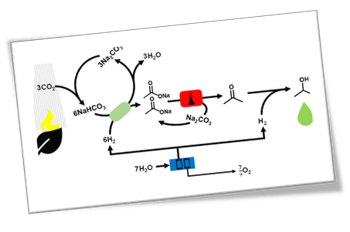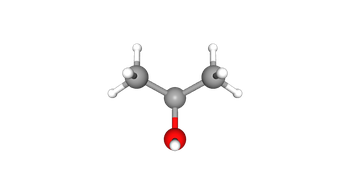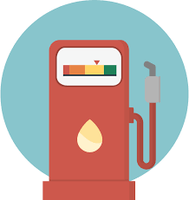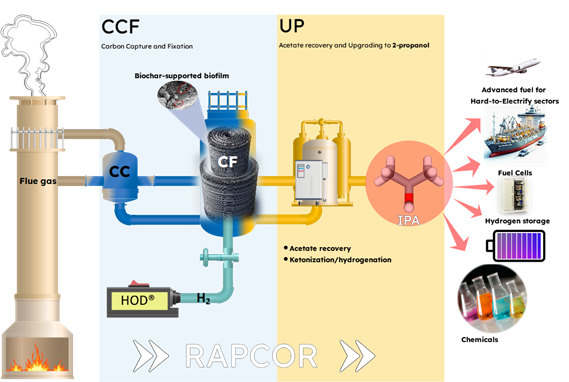RAPCOR (Reliable Alcohol Production Through flue/atmospheric CO2 Recovery) project is a spontaneous research initiative of Pyroteam which aims to deploy a process which can be deployed with bottom-up approach through an open science philosophy.
Considering the actual GHGs emissions trend, humankind has less than 24 years to stop any net emission of CO2.[1] Achieving that target requires a cut in CO2 emission that should be almost total, effective and extremely sharp. Renewable energy technologies are considered a key instrument to diversify EU gas supplies and reduce EU’s dependence on fossil fuels. Among them, synthetic fuels obtained from CO2 are pivotal for the energy transition.
[1] Liu, Z., Deng, Z., Davis, S., & Ciais, P. (2023). Monitoring global carbon emissions in 2022. In Nature Reviews Earth and Environment (Vol. 4, Issue 4, pp. 205–206).

RAPCOR concept aims to cross the border between chemistry and biology, through a natural/artificial process which performs the reaction needed for flue CO2 utilization, namely homoacetogenic fermentation onto a peculiar Char-Based Sparger Reactor (CBSR). This allows using bicarbonate ion (HCO3- obtained from flue gas or air scrubbing) as a source of carbon and green H2 as reductant for the production of percent level of aqueous acetate which, through extraction/ketonization and hydrogenation is upgraded to 2-propanol, commonly named isopropyl alcohol (IPA). Based on the innovative Char-Based Sparger Reactor (CBSR)[1], the concept works at mild pressure and temperature and overcomes most of the limitations of the schemes based on separated CC and CF steps, delivering a potential key building block for the energy transition.


Isopropyl Alcohol (IPA) is a well-defined, high-value (>1000 €/ton)[2] commodity chemical with several unique features: it is a low-viscosity liquid, it has a higher heating value (HHV) of 33 MJ/kg, it is not considered toxic (5 g/kgbw LDoral), it boils at 82°C and possesses secondary hydroxy functionality which provides several advantages for utilization as chemical or solvent. Thanks to its chemical features, CO2 derived IPA can be used for several applications:

Synthetic Fuel: according to its chemical features, IPA is a drop-in fuel with improved characteristics (higher boiling point and HHV) with respect to existing biofuels (e.g. ethanol) and methanol-derived synthetic fuels (e.g. dimethyl ether). Can be easily stored and, in principle used as fuel also within the marine and aviation contexts. On the long term, it has been proposed as one of the most promising fuels for fuel cell applications
.[3]

Hydrogen/Energy storage material: endothermic dehydrogenation of IPA produces acetone and hydrogen, whereas the reversed exothermic reaction store 23 gH2/L.[1] IPA was proposed as hydrogen storage material H2 energy density comparable (3.6 MJ/L) to pressurized hydrogen (3.8 MJ/L for 200 bar H2) without the need for high pressure. In addition, the H2 mediated interconversion between IPA and acetone can be used for new type of heat pumps or to reversibly store/release low-temperature heat for district heating.[2]
[1] Hauenstein, P., Seeberger, D., Wasserscheid, P., & Thiele, S. (2020). High performance direct organic fuel cell using the acetone/isopropanol liquid organic hydrogen carrier system. Electrochemistry Communications, 118.
[2] Xu, M., Cai, J., Guo, J., Huai, X., Liu, Z., & Zhang, H. (2017). Technical and economic feasibility of the Isopropanol-Acetone-Hydrogen chemical heat pump based on a lab-scale prototype. Energy, 139, 1030–1039.

Platform Chemical: IPA prom RAPCOR could be used to obtain renewable propylene (the monomer of Polypropylene), similarly to what happens with ethanol for the obtainment of renewable ethylene (monomer for renewable Polyethylene). Moreover, being a functionalized/reactive 3-carbon atom compounds, can be used to a tree of various chemical commodities which are actually obtained from fossil sources. Even if the use as chemical is not directly related to energy transition, it can provide a boost to the early adoption of the technology, which can be economically driven by the price of chemicals that is higher than that of fuels.

We would like to make it happen...

If you want to join the RAPCOR initiative, just join us in the Open Innovation spirit!